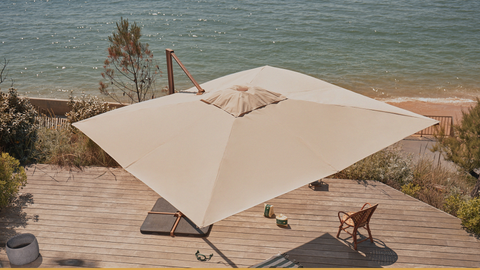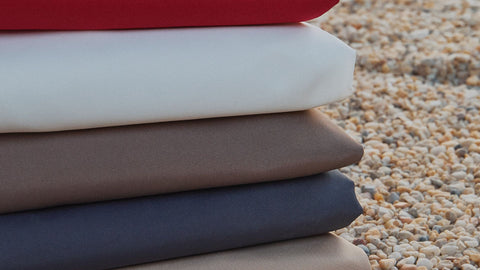Errors to avoid when buying a parasol
Buying a parasol may seem simple, but there are several pitfalls to avoid to ensure you make a good investment. Whether it's for your garden, terrace, or even balcony, here are the common mistakes to avoid when purchasing a parasol.
1. Not considering the size of the space
One of the most common mistakes when buying a parasol is not measuring the space where you intend to install it. This negligence can lead to significant inconveniences. A parasol that is too large can clutter your space, limiting circulation and outdoor space usage, while one that is too small may not provide sufficient shade, making it ineffective.
Why is space size crucial?
The available space not only determines the size of the parasol you can install but also influences the choice of parasol type. For example, a large garden or spacious terrace can accommodate a large cantilever parasol. Our Foehn cantilever model, measuring 3x3m, is specially designed for large spaces, offering ample shade without occupying too much ground space. For a complete outdoor experience, consider including matching patio furniture to create a cohesive look.

Conversely, for a balcony or small terrace, it is more appropriate to choose a small straight parasol like our Pampero model, measuring 2x2m, to maximize space usage.

How to measure the space correctly?
Measure the desired shaded area
Determine the area you want to shade using a tape measure to obtain its length and width. If you have a set of tables and chairs, ensure that the parasol covers enough space to shade everyone. The right measurement ensures that your patio umbrella will cover the necessary area effectively.
Consider the immediate environment
Look around the intended parasol area. Are there obstacles like walls, trees, or furniture that could limit the available space? Take these elements into account to prevent the parasol from being obstructed by its immediate surroundings.
Allow space for the base
Do not underestimate the space needed for the parasol base. Bases can vary in size and shape and should be heavy enough to stabilize the parasol. Ensure that the base does not encroach too much on usable space. In the case of a cantilever parasol, the base will protrude from the shaded area, so this additional space needs to be planned for. An aluminum base is often a durable and stable choice for your patio umbrella.
2. Ignoring base stability
An unstable parasol can be dangerous, especially in windy conditions. Many people overlook the importance of a solid and suitable base, which can lead to parasol falls, risking injury to people or damage to property. Ensure that the parasol base is heavy enough to keep it in place, thereby minimizing the risk of overturning. There are different options such as water-filled bases, sand-filled bases, or heavy metal bases. Choose the one that best suits your needs and environment to ensure not only the stability of the parasol but also the safety of those around it. An inadequate base can quickly become a hazard, especially in spaces frequented by children or pets.
There are three main types of feet to stabilize and move structures, each with its specific advantages depending on the needs.
Ballast slabs are weights made of concrete, steel, or plastic filled with sand or water, used to stabilize temporary structures such as tents or parasols without permanently fixing them to the ground. They are ideal for outdoor events where drilling is not desirable, offering easy installation and great flexibility without damaging the ground.

Wheeled feet allow easy mobility of structures, thanks to fixed, swivel, braked, or unbraked wheels. They are particularly suitable for mobile structures such as carts, display panels, or certain furniture, offering great convenience for movement and repositioning.

3. Neglecting material quality
The durability of your parasol essentially depends on the quality of materials used. Cheap parasols may seem attractive at first glance, but they are often made from lower-quality materials that deteriorate quickly under the effects of sun and weather. It is crucial to opt for robust materials to ensure the longevity of your investment. Choosing an aluminum structure for your parasol has many advantages.
Aluminum is lightweight, corrosion-resistant, and durable, making it an ideal choice for changing outdoor conditions. Unlike more fragile materials, aluminum does not rust, which extends the life of your parasol even with prolonged exposure to the elements.
Regarding the parasol fabric, prioritize materials such as acrylic or olefin. These fabrics are specially designed to resist fading. They are also water-repellent and mold-resistant, making them easy to maintain and suitable for prolonged outdoor use. A sturdy aluminum frame can withstand strong winds and provide stable support for your patio umbrella.

4. Not checking UV protection
A parasol is not just meant to provide shade but also to protect against harmful UV rays. UV rays can cause skin damage, leading to sunburn, premature aging, and increasing the risk of skin cancer. Ensure that your parasol fabric is treated to block these UV rays. For optimal protection, look for parasols labeled with UV protection, such as UPF 50+. UPF, or Ultraviolet Protection Factor, measures the effectiveness of a fabric in blocking ultraviolet rays.
A parasol with UPF 50+ blocks approximately 98% of UV rays, providing an effective barrier against the harmful effects of the sun. Investing in a parasol with high UV protection is essential for the health and well-being of your family and guests, allowing them to safely enjoy sunny days.
5. Forgetting practical features
Modern parasols offer many practical features that can enhance your comfort. For example, tilting parasols allow a 360° rotation to follow the sun's path and maintain optimal shade throughout the day. Parasols with crank or automatic opening mechanisms are also easier to use. A crank mechanism makes it easy to open and close your umbrella with minimal effort. Do not overlook these aspects when making your purchase.
6. Not considering design and aesthetics
A parasol is a visible and often central element of your outdoor space. Therefore, it is crucial to choose a design and color that complement the style of your furniture and outdoor decor. Parasols are available in a variety of styles, colors, and patterns. Take the time to choose one that harmonizes best with your environment. Coordinating your patio umbrella with your furniture sets can create a unified and stylish outdoor area.
Why are design and aesthetics important?
The design and aesthetics of your parasol play a significant role in the overall ambiance and appearance of your outdoor space. A well-chosen parasol can enhance the aesthetics of your garden or terrace, creating a cohesive and pleasant atmosphere. Conversely, a parasol that clashes with the rest of your decor can seem out of place and diminish the visual appeal of your space.
7. Skipping warranty checks
Like any investment, it is essential to check the warranty offered by the manufacturer when purchasing a parasol. A strong warranty can protect you against manufacturing defects and provide peace of mind regarding the durability of your purchase. When reviewing the warranty terms, ensure that it covers a reasonable period and includes protection against various unforeseen circumstances.
8. Not considering maintenance
Finally, remember that your parasol requires some maintenance to remain in good condition over time. Parasol fabrics, in particular, need regular cleaning to prevent dirt, mold, and stains from accumulating. Proper cleaning typically involves using warm water and soap, avoiding harsh chemicals that can damage the fabric.
Moreover, when the parasol is not in use, especially during winter periods, it is crucial to protect it using a weather-resistant cover. Ideally, to maximize its lifespan and keep it in good condition, store it in a dry place, such as a garage. This precaution helps prevent damage from prolonged exposure to sun, rain, wind, and snow. In addition, some parasol structures may require lubrication of opening and closing mechanisms to ensure their proper functioning. Before purchasing, ensure that you choose a parasol whose maintenance is manageable and compatible with your lifestyle.
Conclusion
Buying a parasol may seem straightforward, but it is essential to consider several factors to avoid costly mistakes. By accurately measuring the available space, choosing a stable base, opting for quality materials, and checking UV protection, you ensure the durability and effectiveness of your parasol. Do not overlook practical features and aesthetics, as a well-chosen parasol can greatly enhance the ambiance of your outdoor space. Finally, consider the necessary maintenance to keep your parasol in good condition.
By avoiding these common errors, you will fully enjoy your parasol, adding comfort and style to your garden, terrace, or balcony. For any further questions about parasols, do not hesitate to contact us: Contact Belveo.

















